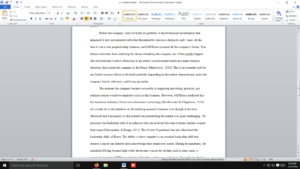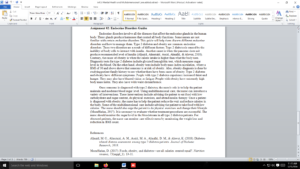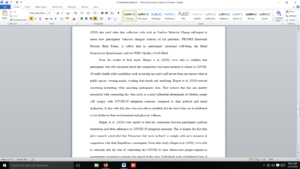This assignment will be a continuation of your corrected effort of Part 1, which you should have saved. That means you must open that file and immediately resave it as follows:
Last name, First Name – PSYC 2301 – PART 2
If you still need to resubmit Part 1 for regrading, be SURE that you write PART 2 on that saved document. When you submit PART 2 for grading, you will see a COMMENTS box in the Submission Link. Put a note in that box asking me regrade PART 1 and I will do so and adjust your grade on Part 1 accordingly.
You will actually be writing Part 2 ON THE COPY Of your first assignment which you have now renamed as Part 2. Renaming it allows you to keep that first (corrected) assignment intact IF you need to redo Part 2.
Placing Your TITLE on Page 3
Go to page 3 of your document. The first thing you will do is copy-and-paste the title of your paper FROM your Cover page onto the TOP LINE of page THREE, OVER “Assignment Title (Same as on Page 1).” The line below that will say Introduction in bold type. LEAVE THAT LINE ALONE and proceed to the first paragraph which begins on the following line. READ the FIRST TWO PARAGRAPHS under the Introduction as they tell you WHAT should be in your Introduction. You will answer TWO questions and NOTHING MORE as Introductions are usually short, at least for a student writer. The information below is CRITICAL for writing your Introduction, so please READ IT.
Questions to be Answered in the Introduction
The questions you must answer in your Introduction are “(1) WHY the subject matter of your article is important (according to the author(s)) and should also indicate WHY the researchers chose (2) the research method used. Research methods used will be stated in the METHODS section of your article and there are a variety of methods. Among the more common methods are (1) longitudinal, (2) cross-sectional, (3) the experimental method, (4) survey research, (5) review of the literature, and (6) correlational method. These are only a few of the various methods used in psychological research; if you encounter one that is NOT explained in the chapter from your text on RESEARCH METHODS, please contact your Instructor IMMEDIATELY for an explanation. Your Introduction section should be approximately three-quarters to one full page in length. Remember that first and second person pronouns are not allowed; you will write in THIRD PERSON and PAST TENSE. Direct quotes are not allowed, everything should be paraphrased (in your own words). Avoid random usage of quotation marks, as in APA Style, quotation marks are an indication of a direct quote and must be cited in a specific way. Direct quotations are NOT allowed in this document, so you should not have any quotation marks. Individual terms do not require quotation marks..
We DO NOT “anthropomorphise.” To anthropomorphise means that we attribute HUMAN qualities to animals or inanimate objects (such as “the article”). If you wish to report something stated in your article, DO NOT say, “The article said.” The article cannot say or do anything because it is either ink on a printed page OR pixels on a computer screen. It is dead, inanimate. You WOULD use the NAMES OF THE AUTHORS, being careful to indicate ONLY their LAST NAMES (all of them) AND the year in which their article was published. For example, if you were using the article regarding the well-being of survivors of sexual assault during childhood, you would cite your comments as follows.
“Barnum & Perrone-McGovern (2017) stated that their participants included 213 undergraduate students from a mid-western university.” This is a PARAPHRASE in that it states WHAT the authors did but DOES NOT use the exact words from the article. EACH TIME you state something you learned from reading your article, YOU MUST PARAPHRASE AND CITE YOUR SOURCE. That means you give credit to WHO actually said what you are reporting and in this case, it would be Barnum & Perrone-McGovern (2017). In all probability, you will need to cite your source every 2nd or 3rd sentence to be sure that you do not commit plagiarism. IF this confuses you, LET ME KNOW SO I CAN HELP YOU.
Let’s return to the two questions you must answer. First, WHY did the authors of your article think the research they did was important? IN the case of the article by Barnum – Perrone-McGovern (2017), the reason is given in the first two paragraphs of their Introduction. Their research indicated that persons who had experienced sexual trauma as a child were more likely than those who had not to have lower self-esteem and feelings of self-worth. Oftentimes you will see that something important was said by someone OTHER than the individuals who wrote your article. You MAY NOT cite that persons or persons because YOU have NOT read their work. YOU must cite YOUR source for that information, which is the authors of YOUR article.
The second question asks about the research methods used by the authors of your article. Sometimes that will be stated in their Abstract or Introduction, but just as often it will not. It WILL be indicated in the METHOD or METHODS section. As stated above, “Among the more common methods are (1) longitudinal, (2) cross-sectional, (3) the experimental method, (4) survey research, (5) review of the literature, and (6) correlational method. These are only a few of the various methods used in psychological research; if you encounter one that is NOT explained in the chapter from your text on RESEARCH METHODS, please contact your Instructor IMMEDIATELY for an explanation.”
Please note that if your article is a Review of the Literature (the article entitled Using social and behavioural science to support COVID-19 pandemic response IS a Review of the Literature), please contact me IMMEDIATELY so I can work with you regarding what -SPECIFICALLY – you need to look for and include in your Summary.
Introductions are BRIEF
You DO NOT need to go into a long-winded explanation of reasons for the research and the method(s) used in your Introduction. That will be done elsewhere. It is enough state the author(s)’ reason(s) IN YOUR OWN WORDS, being sure to indicate ALL their reasons. Following that, indicate the research method use and the NUMBER of PARTICIPANTS (AKA, subjects). Again, if you are unsure of what to do, ASK ME so that I can help you.
What is Included in Your Summary?
Let’s move on to the second part of the Term Project which you will also be writing at this time, and that is the SUMMARY. The Summary begins on the line IMMEDIATELY BELOW your Introduction and the word Summary is centred on the line in bold type. DO NOT begin a new page for this section unless you have completely filled the page with the Introduction, in which case your computer will automatically take you to the next page. READ the instructions for the Summary below, and FOLLOW THEM.
Understand that writing the Summary REQUIRES you to actually READ your article and THINK about what it said. Writing the Summary requires you to have a basic understanding of what you have read and if you do not, LET ME KNOW so that I can help you. Only by actually reading your article can you locate the information required in your Summary, so reread the article before you begin this section. The Summary is the longest portion of your Term Assignment and when reading it, your reader (that would be ME, your Instructor) MUST be able to fully understand what was done, how it was done, who the participants were, and what the results were.
“The SUMMARY section of your assignment will provide an in-depth summary of the article. This summary must include the who, what, when, where, and how of the article. (The introduction submitted in the Introduction was the why.) You will detail the method of selection of the subjects of the research, and when and where the research was done. You must then detail the hypothesis(es) (and there may be more than one), the Research Methods and Research Design used, the results of the research, and the authors’ conclusions. If you do not understand the methods, CONTACT ME IMMEDIATELY SO THAT I CAN HELP YOU!! Use clear and concise terms, explain jargon, and do not use abbreviations unless they are well-known such as U.S.A. DO NOT USE “TEXT” SPEECH. ALL words MUST BE SPELLED COMPLETELY. For all information included in the introduction and summary (and throughout your document), citations must be used, including both parenthetical and non-parenthetical citations. You will only cite the author(s) of the article you read, and this must match the APA Citation on your Reference page. A minimum of two to three full pages is expected for you to fully cover the requirements. If your article is complex, you may find yourself taking as many as four pages to meet the requirements of this portion of the assignment.”











